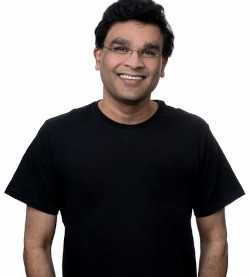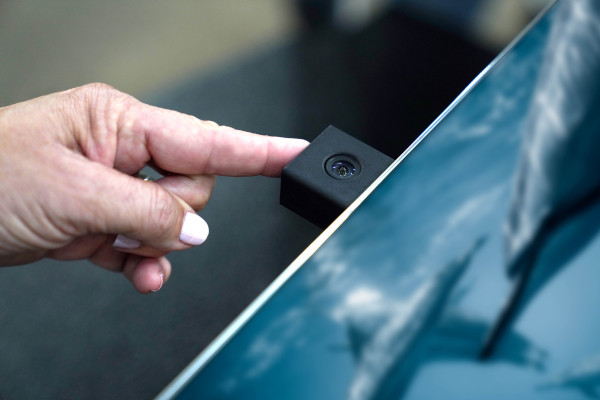Displace Offers a New Take on TV

15 Minutes with Balaji Krishnan, Displace Founder & CEO
Displace, the San Diego-based startup founded by serial entrepreneur Balaji Krishnan in 2022, has a bold vision for the future of TV. He envisions a world in which we are surrounded by a network of super smart TVs that integrate seamlessly into our daily lives. The kind of TV he has in mind was previewed almost a year ago at CES 2023 and is now close to being ready for prime time: It’s super lightweight, runs on batteries, and literally sticks to the wall with the ability to be easily moved from one spot to another. We reached out to Krishnan to get an update on where things stand with his remarkable TV. Here’s what we learned.
Sound & Vision: Let's start with an overview of the concept behind the Displace TV — which is being billed as "the world's first truly wireless TV" — including how the idea came to fruition.
 Balaji Krishnan: At Displace, we envision a world where you will be surrounded by screens everywhere you go. These screens will be interactive and capable of delivering a lot more than entertainment. But to get to that vision, we needed to re-architect TV as we know it today. In order for people to attach multiple screens on walls in their homes, we had to remove two main friction points: 1) we had to make the TV totally wireless to avoid any clutter, and 2) we had to make the wall-mounting process super easy.
Balaji Krishnan: At Displace, we envision a world where you will be surrounded by screens everywhere you go. These screens will be interactive and capable of delivering a lot more than entertainment. But to get to that vision, we needed to re-architect TV as we know it today. In order for people to attach multiple screens on walls in their homes, we had to remove two main friction points: 1) we had to make the TV totally wireless to avoid any clutter, and 2) we had to make the wall-mounting process super easy.
I have been working on making the TV experience better for the past 15 years. Both of my previous startups (Snapstick, acquired by TiVo, and DabKick) introduced unique solutions to solve problems with the TV experience. Displace is the holy grail of what I wanted to achieve in this space. If we put screens everywhere, then we can create a true ambient computing platform to push contextual values to users.
S&V: I'm interested in learning more about the unique aspects of the Displace TV — specifically, the vacuum system used to mount the TV to the wall and the rechargeable battery system. How do they work? And what is the estimated battery life assuming normal usage?
Krishnan: Displace TV has no wires, no ports, and is powered by two internal batteries and four hot-swappable external batteries, so when it’s time to swap out and charge the external batteries, the TV will continue to function. To optimize battery life, the TV communicates wirelessly with a separate AC-powered base unit that sends content and control data to the screen.
The external batteries (photo below) can be easily swapped in and out when they need to be recharged and, with an average 6 hours of active viewing time per day, will last for over a month before you they need to be recharged.

To make the wall-mounting process easy, we designed our TV to be super lightweight from the start. It’s a 55-inch set that weighs around 20 pounds, so anyone can easily pick it up. Then we invented what we call “active loop vacuum technology,” which uses uniquely designed suction cups to attach the TV to any flat surface — including dry walls, painted walls, glass, and more. You simply hold the TV up and it magically sticks to the wall. Once attached, the TV can be easily removed and attached to another wall with the push of a button.
From there, setup is a very simple process. You plug the base unit into an AC power outlet, turn on the TV, and connect the base to your network using an Ethernet cable — or use the Displace App to connect it to your home Wi-Fi and pair the TV with the base unit.


S&V: As we move toward broader adoption of electric vehicles, there has been a lot of discussion about different types of battery technology. What type of batteries are you using for your system?
Krishnan: We are using lithium-ion batteries, but we are also actively exploring better batteries, and alternatives to batteries that will keep the TV running for a longer period of time.
S&V: Talk about control. It's my understanding that you've replaced the traditional remote with a gesture-based control system. How does it work and why did you decide to pursue this method of control, which, if I'm not mistaken, is in addition to more traditional forms of control, including voice?
Krishnan: I think remote controls are not relevant anymore for the streaming era we live in. When you’re 10 feet from the TV, it’s painful to use a remote to navigate the millions of available content possibilities. Plus, using a remote to type on the TV screen is a horrible experience. In our view, the traditional remote control is antiquated and we want to change it.
In my previous startups, I introduced two new user experiences to control the TVs — one with your phone, the other with a dedicated tablet. At Displace, we are introducing a multi-modal user interface that uses hand gestures, voice, and touch. The combination of these interactions will give the best user experience for interacting with a TV. We are also working on another interaction method that will be introduced in 2024.
S&V: The Displace TV also harnesses facial recognition technology. To what end, and how do you address privacy concerns?
Krishnan: Yes, the Displace TV has a built-in pop-out camera (photo below) that is powered with advanced computer vision technology to deliver enhanced experiences to users — like seamless switching content when you walk from one room to another. However, the camera can be pushed back inside the TV if you don’t want to use it. We take privacy seriously and we want the camera controls to be totally optional. Also, the computer vision technology runs locally in the base unit and never goes out to the cloud, so all user data is stored locally.

S&V: Does the Displace TV set-up accommodate cable TV?
Krishnan: The base unit has an HDMI port to which you can connect devices like gaming consoles and streaming devices, but we do not yet support cable TV.
S&V: Let's shift over to the technology inside the TV. What type of display technology are you using, and what level of advanced features are included? I'm thinking specifically of things like high dynamic range (HDR), low-lag gaming, etc.
Krishnan: We are using a 60-fps 4K OLED display that supports HDR.
S&V: How many Displace TV models are currently available in the marketplace, and in what resolutions and screen sizes and at what price points?
Krishnan: Our 55-inch 4K Displace TV is available for reservation with a fully refundable 10% deposit. Prices are $4,499 for one TV, $8,099 for two, and $13,499 for four.
S&V: What have we missed? Please fill us in on any other compelling features or technologies in play.
Krishnan: Displace TV is packed with software features capable of delivering an ambient computing experience. We’ll be showing a few of them in a few weeks at CES 2024 in Las Vegas.
S&V: One last question: How many TVs do you intend to sell in 2024 and what are your plans for the future?
Krishnan: We are planning to scale in 2024. In the future, we plan to keep innovating to achieve our vision of bringing a true ambient computing experience to users by placing screens around them.
For more information on Displace, visit displace.tv.
























































